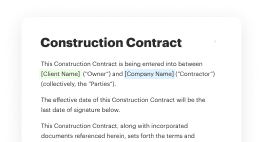eSignature Legitimateness for Government in United States
- Quick to start
- Easy-to-use
- 24/7 support
Simplified document journeys for small teams and individuals




We spread the word about digital transformation
Why choose airSlate SignNow
-
Free 7-day trial. Choose the plan you need and try it risk-free.
-
Honest pricing for full-featured plans. airSlate SignNow offers subscription plans with no overages or hidden fees at renewal.
-
Enterprise-grade security. airSlate SignNow helps you comply with global security standards.







Your complete how-to guide - esignature legitimateness for government in united states
eSignature legitimateness for Government in United States
In the United States, eSignature legitimateness for the Government has become crucial for streamlining processes and increasing efficiency. By using airSlate SignNow, government agencies can ensure compliance with regulations while improving the overall workflow.
How to use airSlate SignNow for eSigning documents:
- Launch the airSlate SignNow web page in your browser.
- Sign up for a free trial or log in.
- Upload a document you want to sign or send for signing.
- If you're going to reuse your document later, turn it into a template.
- Open your file and make edits: add fillable fields or insert information.
- Sign your document and add signature fields for the recipients.
- Click Continue to set up and send an eSignature invite.
With airSlate SignNow, businesses can easily send and eSign documents without the hassle of traditional paper-based processes. The platform offers a cost-effective solution that is tailored for SMBs and Mid-Market companies, ensuring a great ROI.
Experience the benefits of airSlate SignNow today and streamline your document signing process effectively.
How it works
Rate your experience
What is the esignature legitimateness for government in united states
The legitimateness of eSignatures for government documents in the United States is established under the Electronic Signatures in Global and National Commerce (ESIGN) Act and the Uniform Electronic Transactions Act (UETA). These laws affirm that electronic signatures hold the same legal weight as traditional handwritten signatures, provided that the parties involved consent to use electronic means for signing. This framework ensures that eSignatures are valid for various government-related documents, including contracts, applications, and permits, facilitating smoother and more efficient processes.
How to use the esignature legitimateness for government in united states
To utilize the legitimateness of eSignatures for government documents, users can follow a straightforward process. First, select the document that requires signing and upload it to a secure eSignature platform like airSlate SignNow. Next, fill out any necessary fields, ensuring all required information is included. After completing the document, users can send it for signature by entering the email addresses of the signers. Once the recipients receive the document, they can review, sign, and return it electronically, streamlining the entire workflow.
Steps to complete the esignature legitimateness for government in united states
Completing an eSignature for government documents involves several key steps:
- Choose the document you need to sign and upload it to airSlate SignNow.
- Fill in any required fields within the document accurately.
- Enter the email addresses of individuals who need to sign the document.
- Send the document for signature, ensuring that all parties are notified.
- Once signed, the document is automatically stored securely, and all parties receive a copy.
Key elements of the esignature legitimateness for government in united states
Several key elements underpin the legitimateness of eSignatures for government use:
- Consent: All parties must agree to use electronic signatures.
- Intent: The signer must demonstrate a clear intention to sign the document.
- Integrity: The signed document must remain unchanged after signing.
- Attribution: The eSignature must be linked to the individual signing the document.
Security & Compliance Guidelines
Ensuring security and compliance when using eSignatures for government documents is crucial. Users should select a reputable eSignature platform that employs encryption and secure authentication methods. Additionally, it's important to maintain an audit trail that records each step of the signing process, providing transparency and accountability. Compliance with federal and state regulations is essential, so users should stay informed about any specific requirements that may apply to their documents.
Digital vs. Paper-Based Signing
Digital signing offers several advantages over traditional paper-based signing methods. It enhances efficiency by reducing the time needed for document processing and eliminates the need for physical storage space. Digital signatures also provide greater security through encryption and authentication measures, reducing the risk of fraud. Furthermore, eSignatures facilitate easier tracking and management of documents, allowing users to access signed files quickly and conveniently from anywhere.
-
Best ROI. Our customers achieve an average 7x ROI within the first six months.
-
Scales with your use cases. From SMBs to mid-market, airSlate SignNow delivers results for businesses of all sizes.
-
Intuitive UI and API. Sign and send documents from your apps in minutes.
FAQs
-
What is the esignature legitimateness for government in United States?
The esignature legitimateness for government in United States is established by the Electronic Signatures in Global and National Commerce (ESIGN) Act and the Uniform Electronic Transactions Act (UETA). These laws ensure that electronic signatures are legally recognized and enforceable, providing a secure and efficient way for government entities to conduct business.
-
How does airSlate SignNow ensure compliance with esignature legitimateness for government in United States?
airSlate SignNow complies with the esignature legitimateness for government in United States by adhering to the standards set by the ESIGN Act and UETA. Our platform incorporates advanced security features, including encryption and authentication, to ensure that all electronic signatures are valid and legally binding.
-
What features does airSlate SignNow offer to support esignature legitimateness for government in United States?
airSlate SignNow offers a range of features that support esignature legitimateness for government in United States, including customizable templates, audit trails, and secure storage. These features help ensure that all signed documents meet legal requirements and can withstand scrutiny in case of disputes.
-
Is airSlate SignNow cost-effective for government agencies looking for esignature solutions?
Yes, airSlate SignNow is a cost-effective solution for government agencies seeking esignature legitimateness for government in United States. Our pricing plans are designed to accommodate various budgets, ensuring that even smaller agencies can access reliable and compliant electronic signature services.
-
Can airSlate SignNow integrate with other government systems?
Absolutely! airSlate SignNow offers seamless integrations with various government systems and applications, enhancing the esignature legitimateness for government in United States. This interoperability allows agencies to streamline their workflows and improve efficiency while maintaining compliance.
-
What are the benefits of using airSlate SignNow for government documents?
Using airSlate SignNow for government documents provides numerous benefits, including increased efficiency, reduced paper usage, and enhanced security. By ensuring esignature legitimateness for government in United States, our platform helps agencies save time and resources while maintaining compliance with legal standards.
-
How does airSlate SignNow handle document security and privacy?
airSlate SignNow prioritizes document security and privacy by implementing robust encryption and authentication measures. This commitment to security ensures that all electronic signatures are protected and that the esignature legitimateness for government in United States is upheld, safeguarding sensitive information.




























